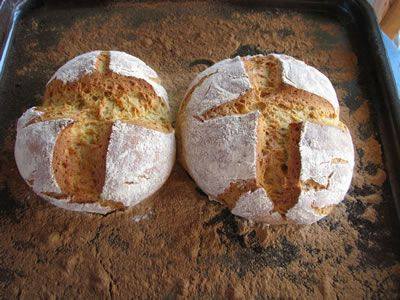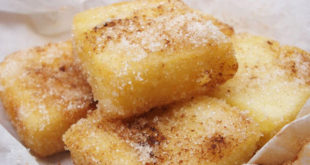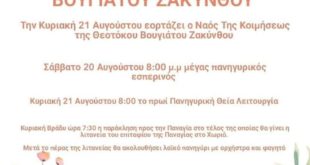Most of my guests that have eaten with us are pleasantly delighted to hear that all our ingredients are home grown, even the wheat we make for our bread. Our village bread is handmade with a recipe dating back to our great grandma’s grandma’s years and it is a certain must at any of our tables. We mainly serve this straight out of the oven, sliced piping hot drizzled with Zakynthian olive oil, during the summer months we even drown it with fresh tomato and then sprinkled with a little oregano. So just what makes our bread special? nothing out of the ordinary, maybe just our home grown ingredients. Here’s the recipe…
What you need to make your own delicious village style bread are:
a) 1 kg of hard flour
b) 1 cube fresh yeast.
c) about 250 + 150 ml warm water
d) a little salt
Bread preparation Instructions
Place the flour into a bowl (keep about a handful of flour – you’ll need it later). The bowl should be twice the amount than the amount that would occupy the flour.
Heat about 250 ml of water to such an extent as to be tolerated comfortably in your hand. If the water is too hot, it will burn the yeast and will inactivate it. This will result in the bread not swelling.
Pour the warm water into a glass and add the yeast. Stir until completely dissolved.
Pour the dissolved yeast in water into the flour and mix well. At this stage, the mixture should stick a little to your fingertips. If this is the case add a little more water about 200 ml of hot water and stir quickly. The water should be warmer than what we used to dissolve the yeast, but not hot. Add enough water so the dough is firm. We do not it runny.
Continue stirring andthen start kneading. Knead the dough with our fists. Mix and knead. Knead and fold. The longer we knead the better the dough and thus our bread will become, so take your time at this stage.
When the dough has formed, add 1/3 teaspoon of salt and continue to kneadso that the salt goes all through the dough.
Now it’s time to let the dough rise.
Place the bowl with the dough of bread into a bag or cover with a tea towel. Place the wrapped bag bowl in a blanket and let to rise in a part of the house that is hot, usually the kitchen if the oven is on is a good place.
After about half an hour and if everything has gone well, remove the bowl from the blanket. If the fermentation is done, you will notice an aroma from the dough, the bread is in the making and you will also notice by the increased size of the dough, it should have doubled approximately.
Knead the dough again. If the dough sticks to your hands slightly, you may want to add a little Zakynthian Olive oil to help with the kneading.
Take a pan and spread some of the flour that you kept in the first step. The floured baking pan will make sure our bread will not stick. This way, the dough will be pressed onto the flour instead of metal.
Prepare for baking:- Now you have kneaded the dough you can also prepare for the next time by taking a piece, about 100g, this we call “prozimi” we use it to assist in making the next batch of bread as the dough will have already been leavened. You may want to freeze this so that you can use it whenever you are ready to make more bread.
Remove the dough a little bit (about 100g) and store in the refrigerator. This small piece of dough is leavened for our next bread.
Now to continue with our bread…Divide the dough in two and make two balls as this will later become our loaf.
Place the balls of dough onto the floured baking tray and move it up and down – side to side, making sure the flour covers the dough whilst on the baking.
With the rest of the flour, sprinkle over the dough balls. Apply evenly the flour so that it embraces all the pastry.
Make a slight cut in a cross like shape on top of the dough.
At this stage the oven should be set to around 200degrees celcius, while you are waiting for the oven to warm let the balls of dough rest, in a warm place. As soon as the oven has set its temperature place the bread in the oven and bake for at least 45minutes.
 Zakynthos Informer Zakynthos Informer
Zakynthos Informer Zakynthos Informer





